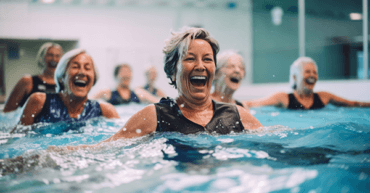March 18, 2024
Sharpen the Brain: Try Retro Walking

By Ram Rao, Ph.D., Principal Research Scientist for Apollo Health
Do you wish to try a new and challenging exercise? Add Retro walking or walking backward to your repertoire of exercises as it strengthens every part of the body, and studies now show potential benefits to memory recall and cognition.
Research suggests that any kind of physical activity offers neuroprotection if you are doing it carefully and mindfully. The three types of exercise that benefit the brain include aerobic, strength training, and mind-body.
Aerobic exercise increases heart rate and intake of oxygen to improve heart function. In addition, it improves blood flow to the brain, preserves brain volume, and activates the brain’s waste-clearance system. Walking and cycling are good examples of Aerobic exercise.
Strength training exercises improve strength, muscle mass, and endurance and provide immense benefits to the brain as well. Weightlifting, hill walking, push-ups, sit-ups, and squats fall under this category.
Mind-body exercises involve awareness-based body movements, including balance, coordination, gait, and agility. Mind-body exercises improve brain structure and function and have a positive impact on executive function, memory, and emotions. Yoga, Pilates, and tai chi are examples of mind-body exercises.
Since movement keeps the brain agile, it would be ideal to combine all three forms when possible. Now, if you wish to try something new, exciting, and challenging as well that benefits the body and brain, try retro walking, aka walking backward or reverse walking. Retro walking is considered a three-in-one exercise — aerobic and strength training and a mind-body connection. Sports medicine professionals believe that in contrast to regular walking, where the forward thrust or power is from the ankle, in retro walking, the power is generated by the hips and knees. It is this switch that offers many benefits:
1. Builds muscle strength Normal forward walking pattern is heel-to-toe. So, as you step forward, your heel hits the ground first, followed by your toes. With retro walking, your toes hit the ground before your heel. The movement pattern makes your legs work harder than walking forward. Retro walking engages and strengthens the quadriceps to straighten the legs and propel them backward. This strengthens the hip and leg muscles.
2. Improves balance and gait and Increases flexibility and range of motion Retro walking changes the normal gait. Thus improving balance, flexibility, and range of motion. While walking backward, the knee straightens before the toes hit the ground for the foot to land. This repeated movement can improve the range of motion and flexibility of the knee, ankles, and hamstrings. Studies now show that when combined with other physical exercises, retro walking can improve gait, walking speed, and balance, especially after an injury or illness. The improvement was especially remarkable in people who had a stroke.
3. Burns more calories than forward walking and boosts heart rate Reverse walking improves cardiorespiratory fitness, allowing the heart and lungs to provide oxygen more efficiently. Since both hip and leg muscles are involved, reverse walking increases heart rate and intake of oxygen, thereby helping burn more calories than regular forward walking. According to the American College of Sports Medicine, reverse walking burns about 40% more calories per minute than walking briskly. Thus, retro walking is an excellent aerobic and strength training exercise.
4. Brain-training exercise Forward walking is an automatic process and does not require any conscious effort. In contrast, since we cannot see backward, each reverse step requires focus, attention, and awareness. Thus, walking backward not only changes the walking routine but also becomes a new learning opportunity for the brain. The prefrontal cortex, which is responsible for cognition, is more active when walking backward. Research studies suggest that retro walking is a good example of mind-body exercise as it improves cognitive abilities, including memory, reaction time, and problem-solving skills.
Before you start a full-fledged retro walking regimen, please remember that there is an element of risk when it comes to walking backward. If you are trying it for the first time, it is advisable to use some sort of aid/support to avoid losing balance. Care also needs to be taken to avoid unseen obstacles, falls, and serious injuries. It is always good practice to consult with a healthcare provider, especially if you have balance problems or any condition that raises your risk of falls. Spring is not far behind, so let us welcome it by adding this new tool to our daily exercise regimen.




